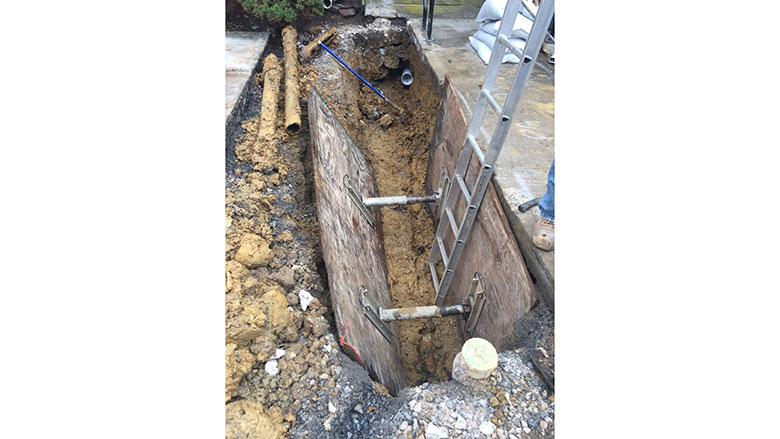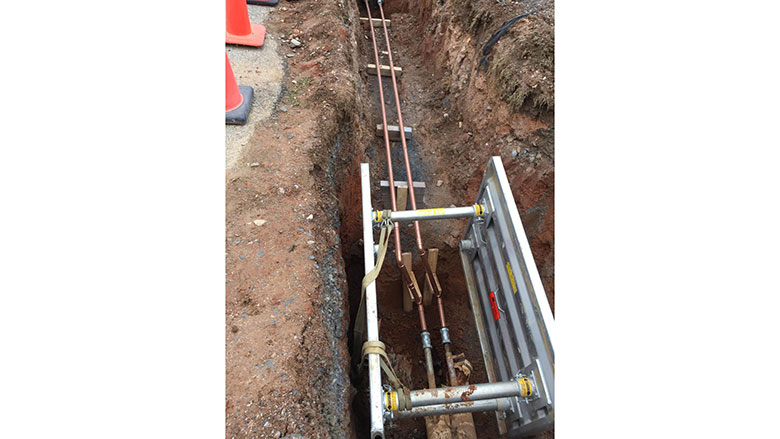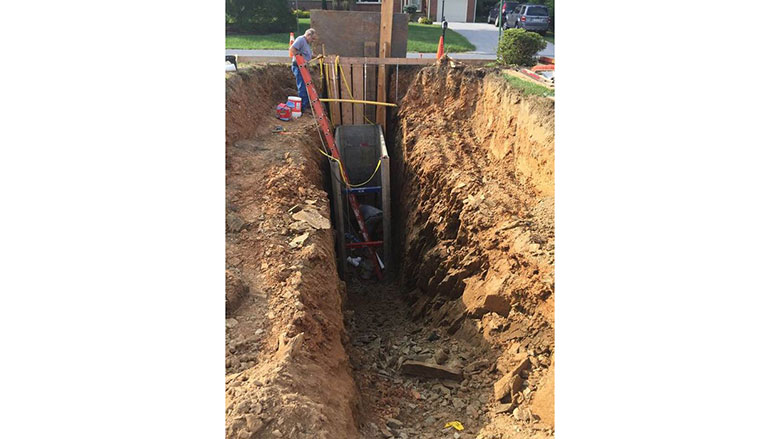Dave Yates: Safety last?
Working in trenches can be dangerous; follow OSHA guidelines to protect against cave-ins.

Lead image courtesy of Mikhail Dmitriev / iStock / Getty Images Plus. Additional photos courtesy of Dave Yates.
Mike Rowe, the “Dirty Jobs” guy, caught a bunch of flak for saying, “safety third.” Seems folks took that to mean Rowe did not consider jobsite safety a priority when, in fact, he was attempting to point out the absurd notion that posted “safety first” signage was a farce. No one is really going to be constantly looking out for an individual’s safety and Rowe was simply trying to convey the message that everyone has to be responsible for their own safety on jobsites.
Pretty much everyone knows shoring or some safety method needs to be deployed for personal safety when working in a trench. OSHA has guidelines for employers and employees to follow that provide minimum standards to provide protection from sudden cave-ins. I can tell you from personal experience that no one can jump out of harm’s way when trench walls collapse suddenly. We all want to go home at the end of the workday to be with our loved ones, and there really is no excuse for cutting corners where trench/ditch safety is concerned. Yet, as 2022 wraps up, this was a deadly year for unnecessary trench collapse deaths with at least 26 fatalities. Two separate deaths in the final weeks just before Christmas.
Who is responsible? While employers rightfully shoulder the bulk of the responsibility, employees bear responsibility too regarding their personal safety and have every right to refuse work conditions that clearly violate OSHA standards. In 1972, I dug a dead plumber out of a collapsed trench where they had been installing a sanitary sewer. He clearly had attempted to jump out of harm’s way because his feet were about two feet above the floor of the ditch and the 4-inch cast iron drainage line. He was instantly crushed between two solid walls of earth. We were working just a short distance away and were also installing a sanitary sewer line in an unprotected trench. My boss, as it turned out, had shoring jacks and heavy oak planks back at the shop. Like far too many bosses, he was more interested in making more money by cutting the corners off of our safety because it took additional time/labor to set up the shoring.
Fast-forward seven years, and my new employer and I were installing a sanitary sewer line for a bank. He too ignored safety by not utilizing any shoring. When he directed me to enter the 8-foot deep trench to pull the township bung and insert the neoprene doughnut and final pipe section, which required lying on your belly, I refused to do so unless adequate shoring was installed. He damn near blew a gasket and threatened to fire me on the spot. The excavator had hydraulic shoring back at their shop, but my boss did not want to “waste time” (read: make less money) by taking the time to obtain the shoring and set it in place. Instead, fussing and fuming, he went down into that trench and performed the work. I did not get fired but got a royal butt-chewing at our weekly shop meeting. From that day forward, they had their excavator bring along their aluminum hydraulic shoring. Safety last? Not for me my friends.
OSHA utilizes a visual triangle for Slope It/Shore It/Shield It when talking about three basic methods for providing personal safety while working in trenches. Any trench 5 feet or deeper must be protected. However, ask yourself this question: When installing a sanitary sewer line in a 4-foot deep trench, will I be kneeling while joining pipe sections or fittings together? What if the trench picks that moment to collapse? A cubic yard of earth weighs around 1.5-tons, as much as a car! If you are kneeling — or lying — on the floor of a ditch and it collapses, even a 4-foot deep trench collapse could be equivalent to multiple cars crushing the life out of you, or your employee(s).
A cubic yard of earth weighs around 1.5-tons, as much as a car! If you are kneeling — or lying — on the floor of a ditch and it collapses, even a 4-foot deep trench collapse could be equivalent to multiple cars crushing the life out of you, or your employee(s).
OSHA also states a competent person must inspect the trench and assess soil conditions. I never once met any plumber, myself included, qualified to “properly” inspect trench soils for safety. If the ditch is deeper than 20 feet, a qualified engineer must perform that inspection. One area of our city had exceptionally deep lateral connections due to the terrain and desire for gravity drainage from homes along the downward-sloping side of roads in that high-end development. Driving to several appointments for estimates, I spied an extension ladder poking above one of the deepest lateral branches. A young lad was at the bottom of the 26-foot deep hole, working by himself, and with no trench protection.
We needed to replace the sewer line under a factory floor and the work had to be done when they were closed. It just so happened that we were working on Father’s Day, and the trench was over 8 feet deep. One employee, who hated shoring, was constantly complaining and kept smacking the shoring’s hydraulic arm with his hard hat, which resulted in a blue streak of cussing that would make a sailor blush! Every time it happened, he would swear, we all would laugh, which made him swear more emphatically! Once our work was completed and the township inspector, who grudgingly agreed to the off-hours inspection, granted approval, we removed the shoring. A few moments later a giant WHOOMPH was heard as the trench walls collapsed — right where our swearer-in-chief had been working. He never again complained about having to utilize shoring. While it was not a common occurrence, that was neither the first nor the last trench collapse following the removal of shoring I witnessed during my career. Always a surprise and always lightning-quick.
Excavators who worked for my firm had to provide hydraulic shoring and/or trench boxes, as needed, or we would not use them as a subcontractor. I certainly wanted to return home alive after a hard day’s work and I never wanted to be faced with telling an employee’s loved one(s) they were never coming home again. “But it costs too much money.” Bullfeathers!
I really like the ease with which hydraulic shoring can be deployed. A long metal key is used to hook the leading handle on the shoring while lowering it into place. The hydraulic hose quick-connect connects to a portable oil-filled canister with a hand-pump to provide in excess of 2,000 psi pressure against the trench walls. After completing your work, the same metal key (much like a water service curb key) has a cupped end that allows you to pop off the quick-disconnect of the now deflated hydraulic line. No need for anyone to enter into the trench for setup or teardown of the shoring.
Most safety issues require common sense solutions:
- Don’t pile materials along the edge of the trench
- Don’t allow the excavator to pile up the spoils along the edge of the trench and the spoils pile edge should be a minimum of 2-feet back from the edge of the trench.
- If the ditch is unstable, even if under 5 feet deep, set plywood and use hydraulic shoring to apply pressure against the plywood. See the below picture of plywood backed shoring in a shallow trench that was unstable due to the wet soil conditions.

- OSHA suggests 8-foot spacing between hydraulic shoring. If you have even the slightest suspicion the trench might be unstable, add plywood sheeting and set the hydraulic shoring closer together.
- Trench boxes are not just for deeper trenches! In the picture below with the copper underground hydronic lines, the ditch walls were comprised of fill ground, which was deemed to be unstable by my crew and they had our excavator install a small version of a trench box for added safety. It was relocated as their work progressed.

- Deep trenches require trench boxes and sloping or benching. In the picture below, you can see we had our excavator bench the trench on both sides and construct a plank wall between the trench box and street to protect our employee from and falling debris.

- Slope it, bench it, shore it or box it.
Hopefully 2023 will see fewer trench injuries and/or fatalities. Zero deaths would be ideal.
Looking for a reprint of this article?
From high-res PDFs to custom plaques, order your copy today!








